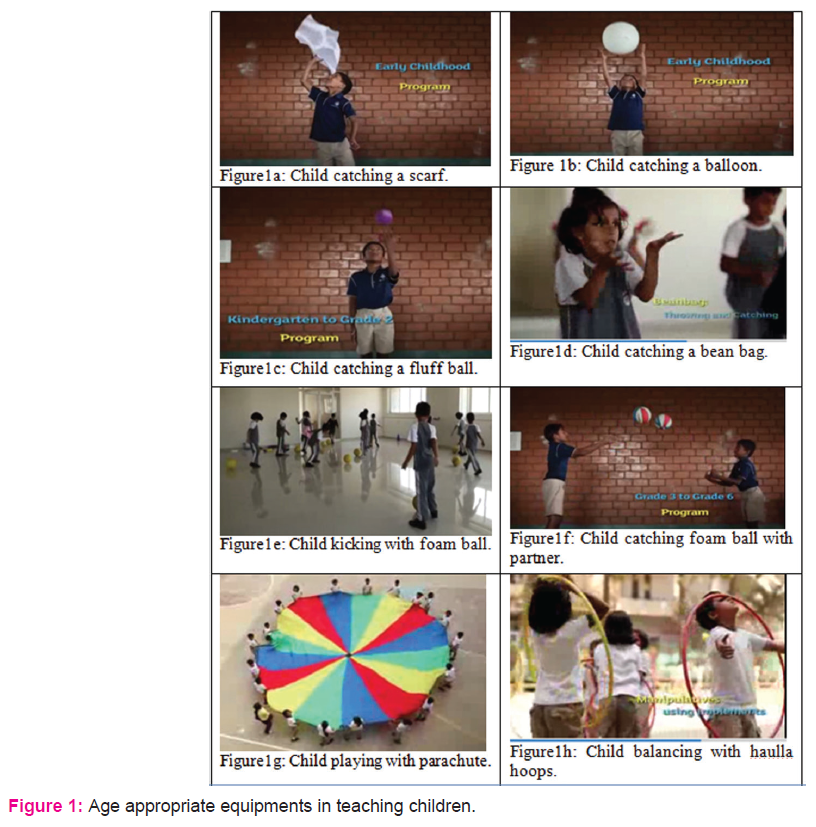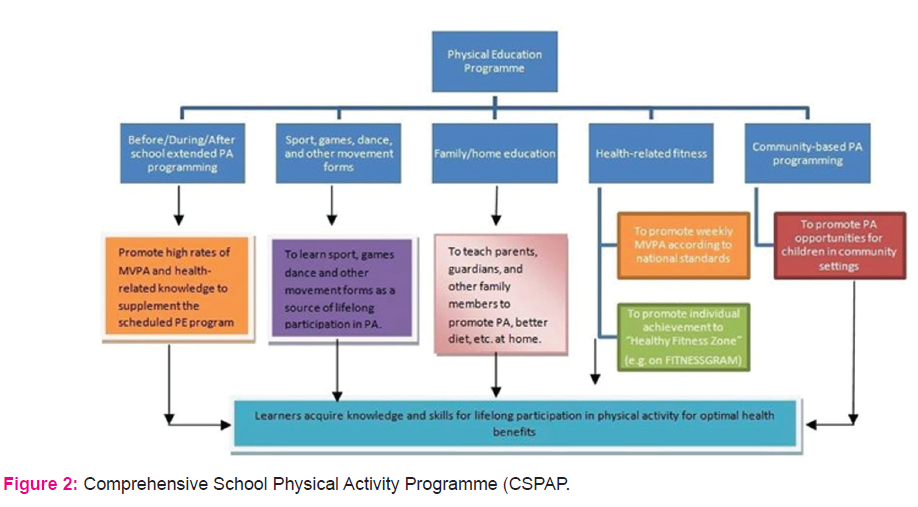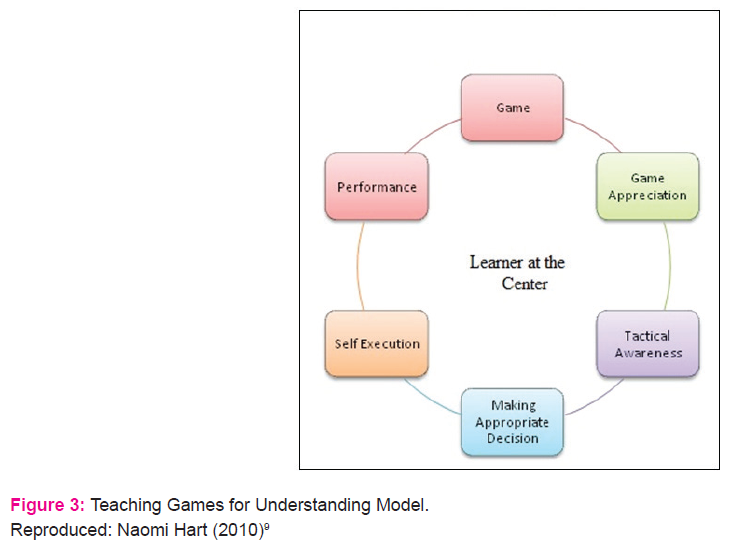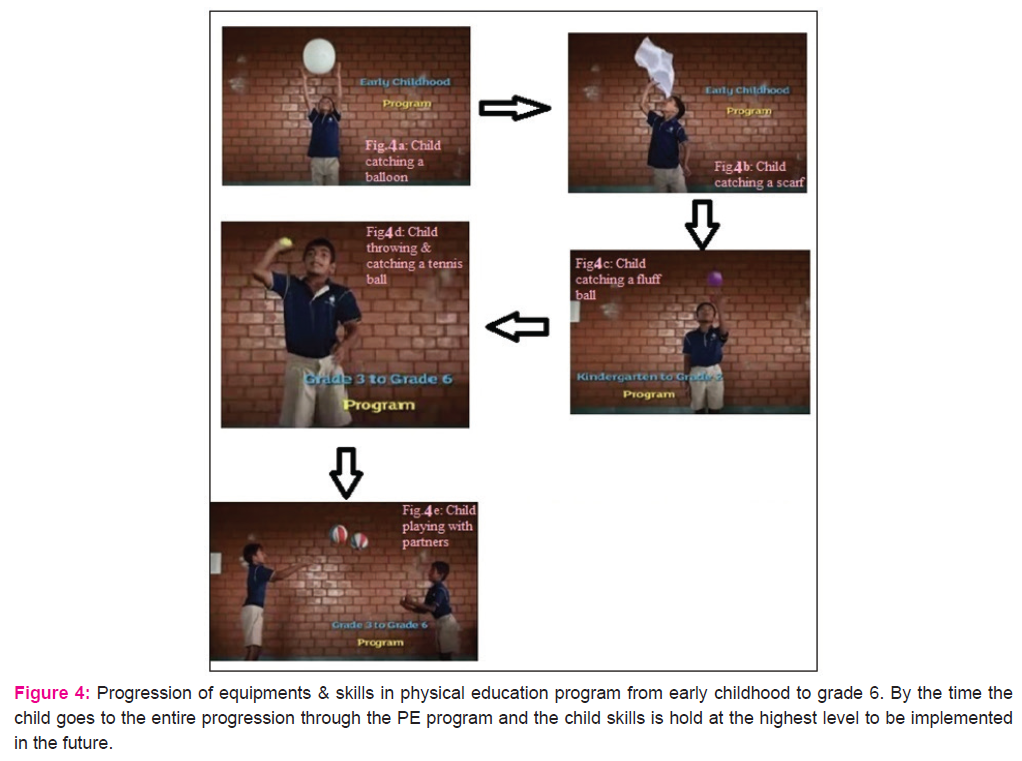IJCRR - 9(16), August, 2017
Pages: 06-11
Print Article
Download XML Download PDF
Innovative Teaching Methods in Physical Education for Better Learning
Author: Ramananda Ningthoujam, Bidhyapati Nongthombam, Moirangthem Sunderchand
Category: General Sciences
Abstract:Introduction: Physical educators have been trying to instil values of fitness for life in the mind of the children. The NASPE (2003) and Institute of Medicine's (2013) recommend that children should obtain a minimum of 60 minutes of moderate to vigorous physical activity (MVPA) in a day.
Aim: This article will highlight the latest teaching strategies, age appropriate equipments, and health optimizing physical education curriculum used in the field of PE program for better teaching and learning process.
Methods: New physical education activities, equipments, physical education curriculum in the field of physical education obtained through Google search, with the keywords physical education curriculum, physical education equipments, age appropriate physical education program, assessment in physical education, Strategies in physical education, and curriculum guidelines for physical education; as well the experience by researchers were expressed in this article.
Discussion: A physical educator has a great role to play at the grass root level to groom a child into making a potential and highly skilled professional. Olympians are not born, but they are made through their lifetime participation in research based PE program from school.
Conclusions: A physical educator has a great role to play in the grass root level to groom a child into making a potential and highly skilled professional. New curriculum, age appropriate equipments, teaching techniques, etc should be introduce in all the schools to make the child engage in physical activity for at least 60 minutes per day. However, the use of innovative equipments, strategies and curriculum in PE classes must be research-based and need for the children.
Keywords: Physical Education, Curriculum, Equipments, School Children
DOI: 10.7324/IJCRR.2017.9162
Full Text:
Introduction
Physical Education (PE) programme has been creating, implementing, and evaluating in promoting lifelong wellness among the school children. Students learn how to make healthy food choices, reduce time playing video games and watching television (Sallis, J. F., and McKenzie, T. L., 1991) 1. Previously, the PE program has been removed from the school curriculum as schools everywhere strive to improve the academic performance of their students, many have cut physical education and recess periods to leave more time for sedentary classroom instruction (Stewart G. et al, 2009)2. Over the years, researchers and educators have revised their PE curricula, equipments and training programs to meet the six NASPE (National Association of Sport and Physical Education) guidelines. In India, Central Board of School Education (CBSE) has made PE an elective subject in school curriculum. The idea of including PE class in school is to make the students healthy and teach them healthy life style. The aim of the study is to highlight the latest strategies, age appropriate equipments, new curriculum, used in the field of PE program for better learning and developing health among young children through physical activity. For this purpose, new physical education activities, equipments, physical education curriculum in the field of physical education obtained through Google search, with the keywords physical education curriculum, physical education equipments, age appropriate physical education program, assessment in physical education, Strategies in physical education, and curriculum guidelines for physical education; as well the experience by researchers were expressed in this article.
Innovative program in Physical Education
Till date the Physical education program in some schools in India have not really changed its methodology, wherein children play a particular sport by sharing one ball in a huge group. And the drawback is that not every child gets the opportunity to play. With the introduction of new curriculum, age appropriate equipments, teaching techniques, etc the physical education class have become more interesting, attractive and more valuable for the students. Researchers and educators are trying to revise their PE curricula and training programs to meet the six NASPE (National Association of Sport and Physical Education) standard guidelines: 1) demonstrates competency in motor skills and movement patterns needed to perform a variety of physical activities, 2) demonstrates understanding of movement concepts, principles, strategies, and tactics as they apply to the learning and performance of physical activities, 3) participates regularly in physical activity, 4) achieves and maintains a health-enhancing level of physical fitness, 5) exhibits responsible personal and social behaviour that respects self and others in physical activity settings, and 6) values physical activity for health, enjoyment, challenge, self-expression, and/or social interaction.
SPARK (Sports, Play, and Active Recreation for Kids), a pioneer organisation in United States, has been contributing in the systemic reform of physical education (PE) since 1989. In addition to the six guidelines of NASPE, SPARK supports Healthy People Goals (HPG) 2010: a) PE classes make every effort to engage students in moderate to vigorous physical activity (MVPA) at least 50% of their class time without sacrificing academic achievement or student enjoyment of PE, b) SPARK focus on positive health outcomes of students. These include physical fitness and sports skills, c) SPARK programs include strategies that promote behaviour and environmental change techniques, and d) SPARK also follows ASAP (As Soon As Possible) activity to avoid the lengthy instruction in Physical education class (SPARK)3.
In India, many organisations such as LEAPSTART (FITKIDS), EDUSPORTS, KOOH SPORTS, SPORTS MENTOR, Physical Education Foundation of India (PEFI), Youth Affairs and Sports (YAS), National Association of Physical Education and Sports Science (NAPESS), and all the physical educators and health educators are also taking initiatives to develop physical education programme to meet the standard guidelines. Recently, Sports Authority of India (SAI) in collaboration Global Trust has launched a new scheme in India called the School Sports Promotion Foundation (SSPF) in 5 sports discipline viz. Athletics, Football, Volleyball, Basketball, and Cricket for talent identification in school children. Its main objective is to provide sports education in children from the grass root level. Sports education includes basics movement’s skills, locomotion, basic skills of the games, rules and regulations of the games, nutritional knowledge, team cohesion, etc (indiatoday)4.
Teaching Strategies
New teaching strategies like AS SOON AS POSSIBLE (ASAP) active games were introduced in PE class to keep the students active as soon as possible, which is one of the physical educator’s objectives. In many traditional PE classes, students arrive at the activity area only to stand or sit and listen to lengthy instructions (SPARK)5. This wastes valuable activity time and should, therefore, be done sparingly. This section includes a variety of enjoyable activities to begin activity immediately. ASAP Activities use little or no equipment, are fun and challenging, and promote health related fitness. They quickly involve all students in moderate-to-vigorous physical activity (MVPA) with few instructions or rules to slow them down. It reduces wasting of time in giving lengthy instruction in the class. Playground Expectation cards, Skills cards, Task cards, etc were also used on the playfield to reduced lengthy instructions.
Another strategy used in PE class is 80/20 RULES, which means that the physical education teacher tries to keep the students active 80% of class duration. Music is also used in PE classes to make more fun activities which interest the students and are also used as start and stop signals.
Limited space activities like BINGO GAMES are introduced which allowed the PE class to run in limited space since space constraint is one of the most common issues in today`s school environment. Whether it be inclement weather (rainy day, smog warnings, extreme heat, etc.) or the usual activity area is unavailable (assembly in the gym, a book fair in the multi-purpose room, the blacktop is getting re-paved, etc.), every so often, the only choice of space for PE is a classroom or other small area. To involve the parents` in PE activities HOME – PLAY games were introduced in PE class which keep the child active at home, and during vacation. It is a take-home page with interesting facts on 1 side, and fun challenges on the other.
Moderate to Vigorous Physical Activity (MVPA) is also introduced during the PE classes to keep the students ready for the next challenges. For example, Chasing and fleeing skills are used in many of the most popular games played by children. By changing the locomotor skill, the method of tagging, the task students perform to re-enter the game after being tagged, and/or the ways in which they may seek safety, you can create enough tag games to last a lifetime. Chasing and fleeing games are usually short in duration (5-10 minutes), and use little or no equipment. The games in this unit provide opportunities for students to develop chasing, fleeing and spatial awareness skills while promoting health-related fitness in enjoyable ways. The activities are designed to include and challenge all students’ physical skills, while maintaining enjoyable, health-promoting, moderate-to-vigorous physical activity during class.
Latest Equipments:
The equipment is one of the backbones of PE classes. In PE classes, it should be age-appropriate and safe to use for the child. Bevans K.B. et al., (2010)6 suggested that age-appropriate equipment increases pain free practice, increases students’ chances for active participation in the class and maximize the amount of time devoted to PE during which children are physically active. Children get maximum activity when every child has a piece of equipment and does not have to wait a turn (Judith E. R et al., 2010)7.
For early childhood, equipments like scarf and balloon (Figures 1a, 1b) are used in learning catching and throwing lessons. In K-2 grade students, bean bags, fluff ball (Figures1c, 1d) are used which falls quickly to gravity and the movement becomes fast. A foam ball (Figures 1e, 1f) is another equipment introduced to teach kicking and trapping in K-2 and 3-6 children. Fun activities like parachute and manipulative games (Figures 1g, 1h) which teach them team work, and develop their upper body strength were introduced to them. All the objects are safe to play and doesn`t hurt the child.
Latest Curriculum:
The National Association for Sport and Physical Education (NASPE) is now endorsing the concept of Comprehensive School Physical Activity Programs (CSPAP) that are designed to increase daily levels of physical activity for all school-age children and youth (Figure 2 ).This new CSPAP curriculum model called Health Optimizing Physical Education (HOPE) that can be used to help Primary to High School (P-12) students to acquire knowledge and skills for lifelong participation in physical activity that contributes to optimal health benefits (Metzler et al., 2013)8. A CSPAP intends to provide expanded opportunities for physical activity beyond regularly scheduled Physical Education time—including before, during and after school, as well as opportunities outside of school (e.g., at home and in the community.
Health Optimizing Physical Education (HOPE) aims at developing the public health goal for students to accrue adequate amounts of current physical activity and be prepared for an active lifestyle in adulthood. It involves all the socio- ecological factors that affect the child so as to achieve the optimal health benefits. They are Individual, Interpersonal, Organizational, Community and Public Policy (Metzler et al., 2013)8.
Another teaching curriculum called Teaching Games for understanding (TGFU) are developed in America to elicit the players`/students’ tactical awareness and skill development from situated learning experience enabled by the teacher/coach/Physical Educationist. Naomi Hart (2010)9 discussed the model of TGFU as (Figure 3): a) Game Participation: The learning in Physical education starts with games participation in a modified game or real games. At this stage the formative assessment takes place, b) Game Appreciation: Through game play students are given the chance to enjoy and experience of learning, c) Tactical Awareness: Through game play students are encourage to identify attacking and defending strategies and implements successful tactical action, d) Making appropriate decision: In dynamic situation students make real time decisions. These could be with or without the ball, e) Skill execution: Do the students have the ability to convert their decisions into actions? Can they execute the correct skill to enable their team to succeed? F) Performance: Students take part in full or modified game applying all new knowledge and skills. This is the time for summative assessments. A detail on TGFU was described by Steven Stolz, Shane Pill (2014)10 and Linda Griffin and co-author (2005)11in the Physical Education Review journals.
Discussion
According to U.S. Olympic Committee, the university’s athletes are dominating the U.S. Olympic Team in which the U.S. has competed since 1912. This Olympians are not born, but they are made through their lifetime participation in research based PE program from school. In the west, children are taught the importance of physical education from the grass root level. A progressive structure is being followed so as to inculcate the basic techniques of movements, skills and a sense of fitness right from early childhood.
PE program has its unique benefits and its program fits into each other. An example of how a progressive structure PE curriculum intertwine and integrate one into other from early childhood, kindergarten and grade 3-6 program can be explained by teaching the skills of throwing and catching. In early childhood, a child would be exposed to the throwing and catching of a balloon (Figure 4a). The weight of descent is slower and gives time to the child to reflex while trying to catch the balloon. As the child gets more comfortable with the balloon, the object is replaced with a scarf (Figure 4b). Since the scarf falls quicker to gravity, the personal space of the child is maintained and safely guarded. In the program for the age group ranging from kindergarten to Grade 2, a slightly heavier object (for example a fluff ball) is used. Since the fluff ball (Figure 4c) is heavier, it will fall faster, which is again age specific and is safer for the child. Therefore, instead of using a big ball to teach children of this age group, a fluff ball is safer and will save their finger from getting hurt. The primary focus is to inculcate gross motor skills in this age group. This activity is a progression of the movement techniques learnt by the children in their early childhood. In this level, the movement is more precise and prepares them to learn higher techniques as the basic techniques of movements will help them in formulating to a better motor program.
In the curriculum for the age group of grade 3 to 6, the action is more defined into a more appropriate throwing action. At this stage, tennis ball (Figure 4d), is used. As they get more comfortable with the tennis ball, the children can be introduced to partners (Figure 4e) so that the skills of the children are groomed and developed to improve their potential, similar to that of playing cricket wherein the ball is actually thrown back and forth to learn catching and throwing skills. By the time the child goes to the entire progression through the PE program and the child skills is hold at the highest level to be implemented in the future.
Conclusions
New curriculum, age appropriate equipments, teaching techniques, etc should be introduce in all the schools to make the child engage in physical activity for at least 60 minutes per day. However, the use of innovative equipments, strategies and curriculum in PE classes must be research-based and need for the children. Physical education program should be one of the major subjects in schools curriculum since the physical educator has a great role to play in the grass root level to groom a child into making a potential and highly skilled professional.
Acknowledgements
Authors acknowledge the immense help received from the scholars whose articles are cited and included in references of this manuscript. The authors are also grateful to authors / editors / publishers of all those articles, journals and books from where the literature for this article has been reviewed and discussed. Special thanks to LEAPSTART, Bangalore, India for sharing us innovating ideas for physical education program.
Source of Funding
None
Conflict of interest
None




References:
[1]) Sallis, J. F., and McKenzie, T. L. (1991). Physical education’s role in public health. Research Quarterly for Exercise and Sport, 62,124–137.
[2]) Stewart G. Trost, Hans van der Mars (2009), Why We Should Not Cut P.E. Health and Learning Pages 60-65 Volume 67 | Number 4
[3]) SPARK. How SPARK Aligns with NASPE’s National Standards for Physical Education. mailto:http://www.sparkpe.org/standardsNASPE.pdf. Accessed on 15th February, 2017
[4])Indiatoday (PTI). Grukul trust launches school sports promotion foundation. http://indiatoday.intoday.in/story/grukul-trust-launches-school-sports-promotion-foundation/1/469116.html. Accessed on 15th February, 2017
[5])http://www.sparkpe.org/physical-education-resources/academics-physical-activity/#sthash.iz3305Xg.dpuf. Accessed on 21th February, 2017
[6] ) Bevans, K. B., Fitzpatrick, L.-A., Sanchez, B. M., Riley, A. W., and Forrest, C. (2010). Physical Education Resources, Class Management, and Student Physical Activity Levels: A Structure-Process-Outcome Approach to Evaluating Physical Education Effectiveness. The Journal of School Health, 80(12), 573–580. http://doi.org/10.1111/j.1746-1561.2010.00544.x
[7] ) Judith E. Rink, Tina Hall, Lori Williams (2010). Schoolwide physical activity: A comprehensive guide to designing and conduction programs. Human Kinectics News and Excerpts. http://www.humankinetics.com/excerpts/excerpts/the-role-and-responsibilities-of-the-physical-education-teacher-in-the-school-physical-activity-program
[8] ) Mike Metzler, Thomas McKenzie, Rebecca Ellis, et al., (2013).Health Optimizing Physical Education (HOPE): A New Curriculum Model. Journal of Physical Education, Recreation and Dance, Volume 84, Issue 4, 2013 pages 41-47, DOI:10.1080/07303084.2013.773826
[9]Naomi Hart (2010), Teaching Games for Understanding. www.naomihartl.weebly.com/blog/archives. Accessed on 20th April, 2017
[10] ) Steven Stolz, Shane Pill (2014)Teaching games and sport for understanding. European Physical Education Review; Vol 20, Issue 1, pp. 36 - 71. doi: 10.1177/1356336X13496001
[11]) Linda Griffin, Joy Butler (2005) Teaching Games for Understanding. Saskatchewan Physical Education Association.
|






 This work is licensed under a Creative Commons Attribution-NonCommercial 4.0 International License
This work is licensed under a Creative Commons Attribution-NonCommercial 4.0 International License